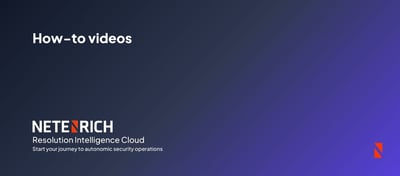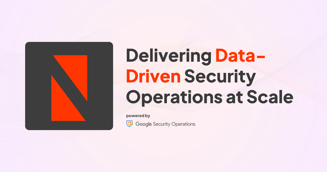Table of Contents
- Step 1: Setting up Google Chronicle Ingestion API
- Step 2: Identify Your Log Sources
- Step 3: Choose How to Collect and Forward Logs to the API
- Step 4: Normalize and Filter Data
- Step 5: Ensure Compliance and Security
- Step 6: Batch and Send Logs via the API
- Step 7: Parsing and Storage
- Step 8: Monitor and Optimize
- Unified Data Strategy: Core Concepts from the Bootcamp
- Troubleshooting common issues with Google Chronicle Ingestion API
- How Netenrich Maximizes Your Google SecOps Investment
- Conclusion
- FAQ's
Key Takeaways
- Use Chronicle Ingestion API to send logs directly into Google SecOps, eliminating the need for third-party forwarders.
- Prioritize UDM-formatted, high-value logs for better detection, faster investigations, and cost control.
- Normalize early and filter smartly to improve signal-to-noise ratio and reduce ingestion overhead.
- Secure your pipeline and monitor continuously to ensure compliance and long-term reliability.
Google Security Operations (SecOps), is a cloud-native platform providing scalable, unified security analytics. Google Chronicle is a cloud-based security operations platform that enables organizOur earlier articles explored what to ingest, from critical log types to hybrid cloud best practices, now lets focus on how to do it, specifically through the Chronicle Ingestion API.
At the heart of this platform lies the Google Chronicle Ingestion API, a direct and flexible method for forwarding security logs from diverse sources into Google SecOps without the need for additional hardware or complicated forwarding tools. How to Use Google Chronicle Ingestion API: A Step-by-Step Guide.
Step 1: Setting up Google Chronicle Ingestion API
Before you start sending logs, you need to prepare your environment:
- Provision a Google SecOps instance: Work with your Google or Netenrich representative to set up your Chronicle environment.
- Create and configure a Google Cloud project: This project will serve as the control plane for your ingestion setup. Enable the Chronicle API and related services.
- Generate service account credentials: Create a service account with the necessary IAM roles (e.g., roles/chroniclesm.admin) and download the JSON key file. This credential authenticates your API requests securely.
- Configure compliance and security policies: Apply encryption, access controls, and data retention policies that are aligned with your organizational and regulatory requirements.
- Understand API endpoints: Use the appropriate regional endpoints for your data ingestion (e.g., US, Europe, Asia).
Step 2: Identify Your Log Sources
Begin by cataloging all systems, applications, and services that generate security-relevant logs. This includes cloud platforms (Google Cloud, AWS, Azure), on-premises servers, firewalls, legacy systems, SaaS apps (like Office 365 or Salesforce), and network devices. Understanding the diversity and location of your sources is critical for designing a pipeline that delivers complete and actionable security.

Step 3: Choose How to Collect and Forward Logs to the API
While the Ingestion API is your final destination, you first need a method to gather logs from their original sources. For example, you might use a lightweight agent on a legacy server to collect logs and forward them to a central script that then calls the Ingestion API.
Step 4: Normalize and Filter Data
Normalize logs into Google’s Unified Data Model (UDM) wherever possible to enable consistent analytics and correlation. For unstructured logs, include the correct log type metadata for proper parsing.
Apply smart filtering to remove:
- Redundant logs (e.g., repeated successful authentications);
- Low-value noise (e.g., excessive debug messages or routine successful logins);
- Irrelevant data that does not support threat detection or compliance.
This will improve signal-to-noise ratio and reduce ingestion costs. Also, don’t forget to prioritize logs that support your use cases, such as threat detection, compliance, and investigations.

Step 5: Ensure Compliance and Security
Protect sensitive data throughout its lifecycle by encrypting logs in transit and at rest, and applying strict access controls. Make sure your data pipeline respects regulatory requirements, data residency, and retention policies. Proper governance is essential for both operational effectiveness and compliance audits.
Step 6: Batch and Send Logs via the API
Group logs into batches (max 1MB per batch) and send them to the Ingestion API endpoint. Each batch is assigned a unique batch ID internally to prevent duplicates.
Step 7: Parsing and Storage
Chronicle automatically parses, normalizes, and indexes your data for rapid search and analytics. All data is encrypted and logically separated by customer account.
Step 8: Monitor and Optimize
Use Chronicle’s dashboards and reports to monitor ingestion health, latency, and data quality. Adjust filters, batch sizes, and collection methods as needed to optimize performance and costs.

Unified Data Strategy: Core Concepts from the Bootcamp
Netenrich’s Virtual Bootcamp emphasizes the importance of a unified data strategy for hybrid cloud environments. To reiterate and sum up what we have been talking about, here are the key pillars, with practical elaboration:
Unified Visibility
Centralized visibility allows teams to detect threats faster and respond more effectively. Therefore, you should aggregate and normalize logs from cloud-native, SaaS, and on-premises systems to gain a single-pane-of-glass view for security, operations, and compliance.
Data Normalization
Translate varied log formats (JSON, syslog, CEF, Windows Events) into a common schema like UDM. This unlocks advanced analytics and threat detection capabilities since Chronicle can correlate and analyze all ingested data consistently.
Ingestion Architecture
Adopt a multi-path approach using agents, APIs, Pub/Sub pipelines, or storage buckets. This flexibility will allow you to ingest data from any environment and adapt as your infrastructure evolves.
Filtering & Routing
Apply advanced filtering to drop low-value data and route only necessary logs to Google SecOps. Use log shippers or edge processing to mask PII, enrich data, and direct logs to the right destinations (e.g., SIEM, cloud storage).
Governance & Compliance
Classify and protect your sensitive data, enforce access controls, and respect data residency and retention requirements. Good governance ensures that you meet all regulatory demands and maintain operational integrity.
Troubleshooting common issues with Google Chronicle Ingestion API

Read on to determine the answers to any of the following issues:
- Authentication Errors: Verify service account credentials and IAM role assignments.
- Missing Logs: Confirm logs are sent in the correct format with proper log type metadata. Avoid sending duplicate batches with identical batch IDs.
- Parsing Failures: Check that logs conform to the UDM schema or include necessary fields for unstructured log parsing.
- API Rate Limits or Payload Size Errors: Do not allow batch sizes to exceed 1MB and respect API rate limits.
- Network Connectivity Issues: Confirm network access to the appropriate regional API endpoints.
- Compliance Alerts: Review encryption and access control configurations.
How Netenrich Maximizes Your Google SecOps Investment
Netenrich is a certified Google SecOps partner, offering expert-led implementation, continuous engineering, and ongoing support. Netenrich offers the following solutions to help you make the most of Google SecOps.
- Expert-Led Implementation:
Rapid deployment and tailored configuration for your unique environment, ensuring a smooth transition to Google SecOps. - Continuous Engineering:
Ongoing optimization of ingestion pipelines, detection rules, and automation playbooks to keep your security operations effective and efficient. - Unified Visibility:
Aggregate and normalize logs from all sources for a single, unified view across your hybrid and multi-cloud environments. - Training and Enablement:
Hands-on training and enablement sessions motivate your team to feel confident and capable with Google SecOps tools and best practices. - Ongoing Support:
24/7 monitoring, regular security reviews, and continuous improvement to keep your operations resilient and efficient.
Conclusion
- The Google Chronicle Ingestion API is a powerful, flexible tool for ingesting security telemetry directly into Google SecOps, enabling unified, scalable threat detection.
- Google Chronicle is a cloud-native security operations platform that normalizes, indexes, and analyzes massive volumes of security data across hybrid and multi-cloud environments.
- A successful ingestion strategy involves identifying all log sources, selecting appropriate collection methods, normalizing and filtering data, securing the pipeline, and continuously monitoring ingestion health.
- Leveraging Netenrich’s expertise and best practices from our Virtual Bootcamp can accelerate deployment, optimize ingestion pipelines, and enhance your operational effectiveness.
- Proactive troubleshooting and adherence to API limits will give you smooth and reliable data ingestion.
By following this guide, organizations can unlock the full potential of Google Chronicle and the Ingestion API, strengthening their security posture and operational resilience.
To understand how best to leverage hybrid cloud data and ingest it into Chronicle, make sure you check out Netenrich's Google SecOps 101 virtual bootcamp.
Frequently Asked Questions
1. How do I send logs to Google Chronicle using the Ingestion API?
First, enable the Chronicle API, set up service account credentials, and gather logs from your sources. Normalize them to UDM where possible, batch them (≤1MB), and send to the regional API endpoint using authenticated requests. Chronicle parses and indexes the data automatically for search and analysis.
2. What types of logs should I prioritize when using the Chronicle Ingestion API?
Prioritize high-value security logs that support detection, compliance, and investigations such as authentication events, firewall logs, DNS queries, and endpoint alerts. Understand your use cases and focus on logs that provide visibility into user behavior, lateral movement, or potential threats. Filter out unused logs to control cost and improve signal quality.
3. How do normalization and filtering improve Chronicle ingestion efficiency?
Normalization translates diverse log formats into a common schema within Google Chronicle, enabling unified search and faster correlation across sources. Filtering removes low-value or redundant data before ingestion, reducing noise, improving alert fidelity, and cutting storage costs.
Together, they help your SOC focus on real threats, strengthening your overall security posture.
4. What are the best practices for securing and monitoring a Chronicle ingestion pipeline?
Encrypt logs in transit and at rest, enforce access controls, and use regional API endpoints that align with data residency rules. Monitor ingestion health with Chronicle dashboards, track error rates, and regularly review filtering rules. Always test changes in a safe environment before applying them to production.
5. How can Netenrich help streamline and optimize my Google Chronicle ingestion strategy?
Netenrich helps you identify the right log sources, normalize to UDM, and optimize filters for cost and detection. We’ve helped enterprises like CSG cut onboarding time from weeks to hours. As a certified partner, we’ve helped enterprises accelerate threat detection by 10X while reducing noise by 70%.





